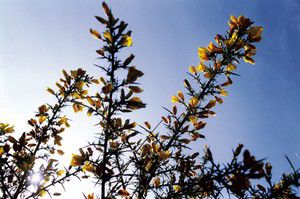Gorse, loosestrife enjoying our warm spring
Published 5:00 pm Tuesday, April 13, 2004

- <I>DAMIAN MULINIX photo</I><BR>Though beautiful from afar, the spiny shrub gorse is at the top of the county weed list.
PENINSULA – While driving over the little bridge on Stringtown Road near the Ilwaco airport you may glance over to the west and see a field lush with yellow flowered shrubs. At first sight you might guess Scotch broom, but get too close and the sharp spines will tell you otherwise. So what is this beautifully painful plant?
Why it’s gorse, of course.
Ulex europaeus in Latin, gorse is thought to have been introduced in the United States as early as 1894 from Ireland as an ornamental shrub. First in south-coastal Oregon, it has spread as far south as San Diego County, Calif. and north through Washington into coastal British Columbia. Gorse has had a place on the Pacific County weed list for the last dozen years.
Tim Wilson heads up the county’s department of vegetation management and has been actively enforcing state RCWs against gorse for the last five years.
“We have a couple of different options,” he said. “We send out a violation letter first to make them aware of the options they have.”
Wilson said they usually send out a letter about 30 days before coming and inspecting the area. If the gorse shrubs are not dealt with by then, the property owner is issued a ticket – the first offense is $475 and can double per offense, per weed species, per day after that.
Now this may seem like a harsh penalty for having a shrub in your front yard, but ask the people of Bandon, Ore., what they think about gorse.
In 1936, the town of Bandon was burned to the ground, 14 people died and only 16 buildings remained unburned – the disaster was fueled by extensive infestations of gorse. The spiny evergreen shrub, a member of the pea family, grows dense and stiff, forming impenetrable thickets. Vigorous stands grow outward, crowding out all other vegetation and forming a center of dry dead vegetation. This, in combination with the oil content of the plant, presents a major fire hazard.
And gorse is not easy to get rid of. From early spring, yellow pea-like flowers develop in clusters on the ends of its branches, becoming hairy black seed pods by late summer. A typical shrub produces about 8,000 seeds annually. Gorse seed can lay dormant in the soil for up to 40 years and still germinate. Soil disturbance such as road construction or tree harvesting present opportunities for the successful germination of seed.
“It is hard to eradicate it from your property,” said Wilson. “It is not that difficult though to control the gorse.”
Wilson said that controlling the established plants with the use of herbicides and cutting and treating the stump have all had high success rates. Once the existing plants are taken care of, then the property owner will have to continually monitor the area, pull seedlings and establish ground cover in order to keep the gorse from growing back – “a long term process” said Wilson.
But this can be successful. Wilson noted an area just south of Oysterville which only 10 years ago was overgrown with gorse, but now thanks to the diligence of the land owners, is under control.
“It devalues property,” Wilson said. “Like most noxious weeds, it kills plants that should be there.”
Of the 15 named to the county weed list, gorse as right up at the top, along with Spartina. Another that is on the list and on the rise in the county is purple loosestrife, Lythrum salicaria, a tall plant with purple flowers on its head.
Loosestrife is growing in its presence in wetlands all over America. The concern is that it displaces native wetland plants and creates a monoculture – taking over so that it is the only plant in an area. This can affect native birds and animals.
So far, there are only small sites around the county, including South Bend, the mouth of Columbia River, the boat launch at Megler and along the banks of Baker Bay. Wilson said they have had good luck so far in controlling the loosestrife growth using a method of biological control – a bug – the leaf eating beetle, Gallerucella calmariensis. They got the idea from Grant County, in eastern Washington, where there had been a high level of success with the beetle.
“Three years ago we turned them out into an infestation in Baker Bay, we were hoping they would get established,” Wilson said. “It’s looking pretty promising right now.”
Wilson said that prior to using the bug, research was done to make sure that the introduction of the beetle wouldn’t harm the existing environment.
If you see what you think may be loosestrife or gorse, call Wilson. He encourages people to call him, even if they end up being wrong. Better safe than sorry, he says.
“That’s what we’re here for,” he said. “We’ll come out and do a site visit. Prevention is the best cure. If we can find something that’s new to the area early, then that’s the route we want to go.”
You can reach Wilson at 642-9425.

